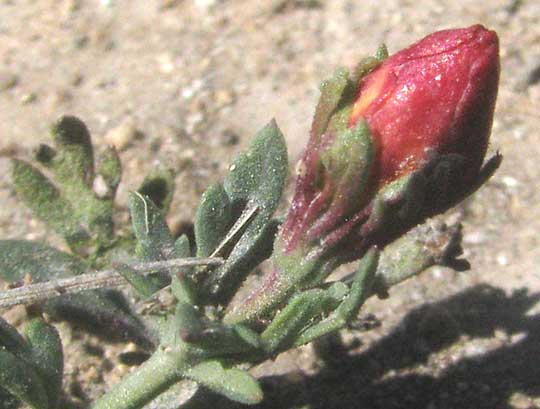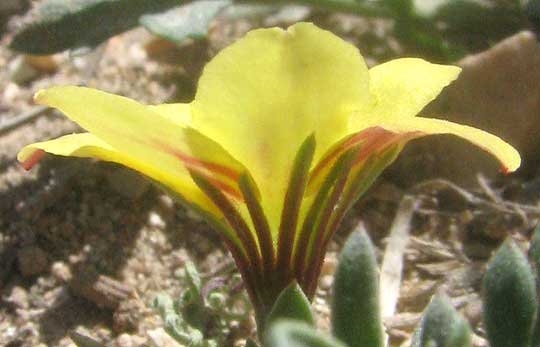Excerpts from Jim Conrad's
Naturalist Newsletter

from the March 17, 2013 Newsletter issued from the valley of the Dry Frio River in northern Uvalde County, southwestern Texas, on the southern border of the Edwards Plateau; elevation ~1750m (~5750 ft); N29.62°, W99.86°; USA
MENODORA, LOVER OF SUN & WIND
During the walk I'd been scanning the woods edge and the understory for spring wildflowers, but there were none. However, returning home, in mostly bare, sun-scorched, windblown, drought-cracked, deer-trampled clay at the gravel road's edge finally I did spot something new, a small, sprawling, silvery-leafed, sand-encrusted plant with bright yellow blossoms about ¾-inch across (20mm), as shown above.
A close-up of a flower with its spherical stigma and two shorter stamens well exserted from the corolla tube, beside the plant's deeply incised leaves appears below:

This blossom was unusual because of its prominent stigma and only two stamens. The more typical arrangement for such a flower would be to have an inconspicuous stigma down in the corolla tube, and five stamens. For a better look at the quirky bloom I tugged at the corolla and the whole thing came loose as if it were just lying in its calyx. In fact, now I noticed that already that morning several flowers had opened, wilted, and fallen to the ground. Breaking the corolla in my hand lengthwise along one side, I opened it up and saw how the stamens were attached to the corolla tube, as shown below:

I couldn't recall having ever seen such a large, yellow, radially symmetrical blossom with only two stamens attached to the tube wall. What family would such a flower belong to? The deeply incised leaves arose in pairs at each stem node, as if we had a member of the Mint or Verbena Families. Flower ovaries in those families are deeply to somewhat 4-lobed, but these flowers' ovaries weren't. However, often parts of such 4-lobed ovaries abort and the developing fruit turns out looking more or less like what I was seeing. I decided that the scrappy little plant probably belonged to the Verbena Family, largely because certain creeping, dry-place-loving Verbenas bear leaves somewhat like it. However, the blossom certainly didn't look like a Verbena flower! Really, this plant was a mystery, and that was great.
After wasting a couple of hours imagining the little plant to be a member of the Verbena Family finally I figured out that it was something else entirely, and much more interesting. The plant in our photo is MENODORA HETEROPHYLLA, sometimes known as the Low Menodora, or Redbud. To Easterners used to Redbud trees, the name Redbud may sound out of place, but when you see a corolla of this plant about to open up you understand immediately where the name came from. You can see such a flower bud below:

Below, a view of the underside of a freshly open flower shows what happens to the buds' crimson surface area:

The Low Menodora is a member of the Olive Family, the Oleaceae. Other members of the Olive Family North Americans might be familiar with include Privet shrub, Jasmine, Lilacs and ash trees. And they all look very different from our little ground-hugging, yellow-flowered plant.
The Low Menodora is described as living on clay, gravel and sandy loam of caliche outcrops and rocky hills, as well as in mesquite pastures in central and southern Texas, south to central Mexico... and, amazingly, in Botswana, southern Africa. The plant's occurrence in two such widely separated distribution areas as Texas and Botswana is highly unusual, and as of yet is unexplained. The two populations became separated a long time ago, however, because now they constitute two distinct varieties. In other words, the populations separated long enough ago for them to have evolved different features, but not long enough ago to have formed two completely different, genetically isolated species.